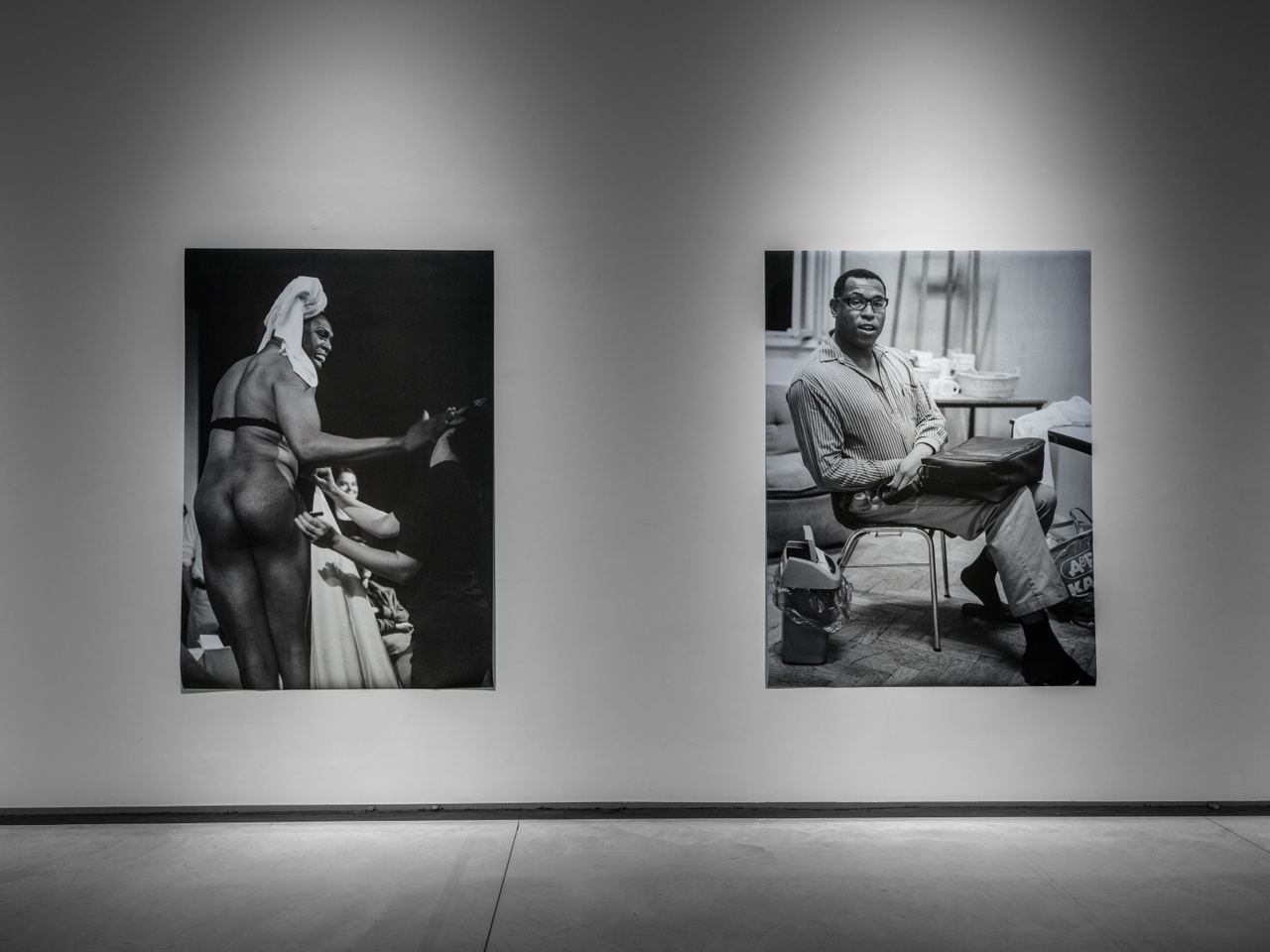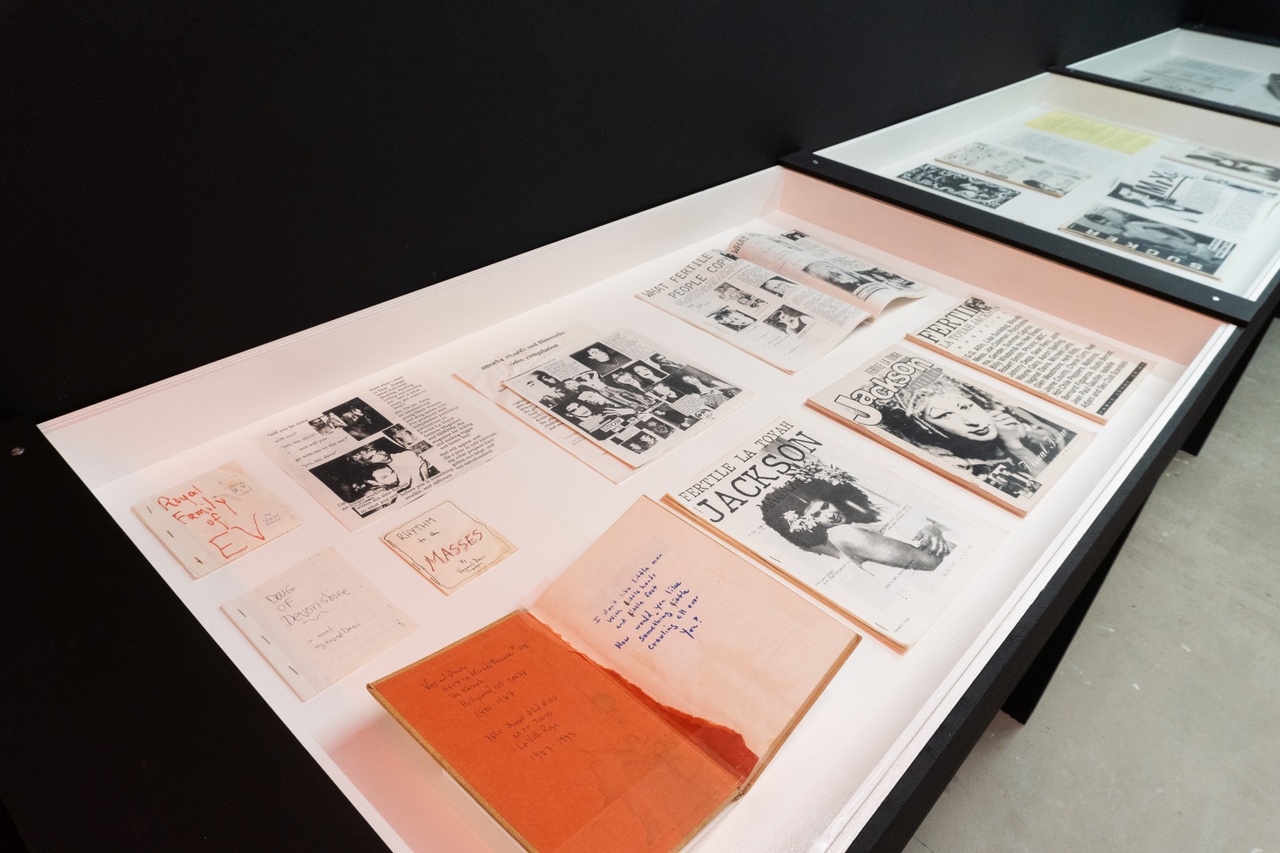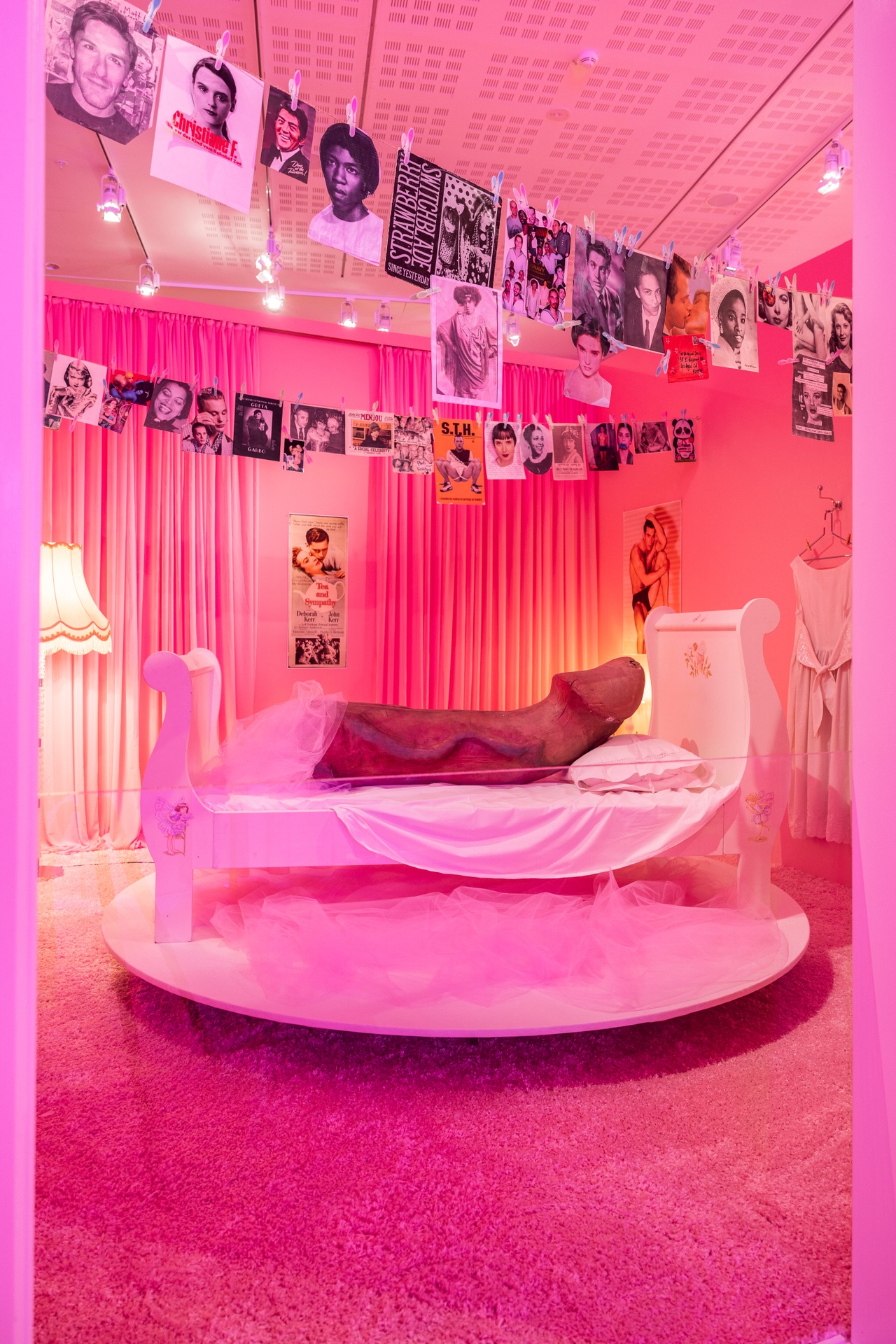SHE IS SET FOR LOVE FROM HEAD TO TOE Marie Arleth Skov on Vaginal Davis at Moderna Museet and five other venues, Stockholm

“CHEAP: Choose Mutation,” Accelerator, Stockholm, 2024
“Money is like manure. It’s no good unless you spread it around,” said the fictional matchmaker and mid-century musical character Dolly Levi, to whom Vaginal Davis has occasionally compared herself. [1] Well. Love is like manure, too. No good unless you spread it around. This, Vaginal Davis knows, too. And so, her current multi-venue show in Stockholm is nothing less than a lovefest. Fertile beyond all means (just like La Toyah Jackson, but more on that later).
Vaginal Davis is a Black-feminist, queer-core, terrorist-drag, punk-rock, glam-queen legend. She grew up in South Central Los Angeles as the child of a 40-something Creole Choctaw mother and a 20-something Mexican American Jewish father (as Davis alleges, the two met each other for a one-night stand under a table at a Ray Charles concert at the Hollywood Palladium). Born intersex, she calls herself a “hermaphrodite” and a “sexual repulsive” [2] who never really fit in: “Honey, baby doll, I’ve always been too weird for any scene I’ve ever been in.” [3] Instead, she formed intimacies, close collaborations, and family-like friendships with other artists, musicians, and writers. In the many letters to her from associates, printed in the exhibition catalogue, she is called in turn “sister,” “auntie,” “daughter,” “mama.”
She named herself after her heroine, Angela Davis, with an explicit twist. Vaginal Davis spent her childhood with her lesbian mother and four sisters, “in an all-female household, where ‘goddess reverence’ was daily sustenance,” as Amelia Jones reports. [4] Sisterhood is a leitmotif throughout her many-layered and multimedia bodies of work, from her 1970s art-punk band The Afro Sisters to her latest series of icon paintings depicting femmes and feminists, such as Octavia Butler (pioneering Black science fiction author), Elsa Maxwell (gossip columnist, radio personality, and hostess of notorious parties), Sonia Sanchez (godmother of the Black Arts Movement), and June Jordan (poet, activist, and Black-feminist icon), among many others.
Vaginal Davis herself is many. Not only has she appeared in myriad stage identities, from Latina girlie popstar Graziela Grejalva to drag king Buster Beauté, but her artwork is kaleidoscopically disparate. The contexts of her work, likewise, span from her early, fugitive performances in the LA punk scene, to her move to Berlin in 2005 and her work there within the CHEAP collective, to her most recent art environment installations, such as The Fantasia Library, part of the The Wicked Pavilion (2021).

“Vaginal Davis: HOFPFISTEREI,” INDEX, Stockholm, 2024
It makes sense, then, that curator Hendrik Folkerts of Moderna Museet has pulled out all the stops and organized a six-venue show in Stockholm, where each place focuses on a different sphere, a different aspect, of Vaginal Davis’s work. At the time of my visit, there were four exhibitions to be viewed on-site, and in September, Moderna Dansteatern and Tensta Konsthall will join with their live programs, for which Davis will be present in Stockholm, leading Vaginal Davis’s Universität for the Damaged and Gifted, among other things. So, let’s do the rounds.
First up: Kungsholmen, the king’s islet, where the small art center Index presents an archival reading room of Vaginal Davis’s extensive practice as a writer from the 1980s till today: poems, critiques, articles, novels, gossip columns, etc. Charmingly, a large chunk of the zine collection is presented either in copy to be read and held in your own hands (there is even a Xerox machine to make your own copies) or as transparencies that you can put onto an old-school overhead projector. The two most well-known zines she has produced, Fertile La Toyah Jackson (1982–91) and Sucker (1995–97), are highly entertaining and dangerous reading, with sharp social observations and absurd porn. The famous Vaginal Davis blog Speaking from the Diaphragm (“read by 15 million boys!” suggests Vaginal Davis [5]) is presented on a 1990s iMac. The presentation at Index is a reminder that Davis started out as a poet and spoken word artist and a reminder of the glorious fun and tragic earnestness of gossip. As Truman Capote famously said, “All literature is gossip, certainly all prose-narrative literature. What in God’s green earth is Anna Karenina or War and Peace or Madame Bovary, if not gossip?” [6]
Meanwhile, at Accelerator – a raw, concrete-walled space formerly used as an underground laboratory for research in accelerator physics and now turned art venue – it feels like Berlin. On show is “Choose Mutation” by CHEAP, the Berlin-based artists group of which Davis has been a member since the early 2000s. The title is taken from Paul B. Preciado’s exposé on chosen mutation as the only way to avoid submission. There are black-and-white life-size photos of the CHEAP comrades by Annette Frick, a free newspaper, a rusty speaker pole, found sounds and original music by Xiu Xiu, and a video presented on a custom-made motorized billboard that can physically split screen. In their entirety, these exhibits radiate paranoia and party, rebellion and rhythm, metal and media, codes and control, techno and theory. In the video, big flashing yellow letters announce, “SHE IS SET FOR LOVE FROM HEAD TO TOE.” Brace yourselves.
By contrast, at the Nationalmuseum is the dreamy, soft exhibition “Naked on My Ozgoad or: Fausthaus – Anal Deep Throat,” which Vaginal Davis made in collaboration with the artist Jonathan Berger. Next to the original Oz illustrations, Berger and Davis have filled the atmospheric Gamla Biblioteket (Old Library) with miniscule shimmering statuettes, vibrant murals, little tomes on velvet pillows, and a whispering voice installation. The Marvelous Land of Oz as imagined by L. Frank Baum in his series of 14 Oz books (published 1900–19) was a loving refugium for outcasts. As the wall text notes, the characters in the Oz books are suffragettes and transgender, eccentric and fantastic.
Finally: “Magnificent Product” at Moderna Museet, the mother lode among the venues. The focus here is both on work Davis produced back in Los Angeles – bands, films, and her in-home Sunset Strip gallery HAG – and on her latest installations, all-rosy encompassing environments of her imaginary library and dreamed-up girl’s bedroom. The display colors are 1950s American diner: pink and turquoise. Behind a tulle veil is a wall full of explicit photos from parties and performances. Hollywood and homocore, all very sweet and outrageous.

“Vaginal Davis: Magnificent Product,” Moderna Museet, Stockholm, 2024
In the Carla DuPlantier (for the punks: that’s “Maddog” of the Controllers) Cinerama Dome, replete with cardboard replicas of palm trees, the audience is presented with Davis’s films, such as the silly-sad That Fertile Feeling (1983, in which La Toyah Jackson gives birth to 11 babies and then rolls off on her skateboard); the distorted parody of right-wing extremism The White to Be Angry (1999, still appallingly relevant today); and The Last Club Sucker (1999, in which Vaginal Davis offers blow jobs to random men, most of whom become visibly embarrassed). Davis often uses self-exoticization as a weapon.
In Davis’s exhibition at Moderna, men and boys are sexualized, women and girls are idealized. A long pink corridor shows Davis’s miniature portraits of historical queer and female idols, painted on hotel stationery and club flyers, using liquid eyeliner, nail varnish, hair spray: “My paintings are kind of a feminine totem style. It’s all about female imagery, and female worship.” [7] The iconography is a mash-up between medieval religious icons, expressionist colors, pop glitter, and an appropriation of everyday printed materials that might even make you think nouveau réalisme. Poets are key: Erika Mann, Wanda Coleman, Ingeborg Bachmann, Audre Lorde. At the end of a labyrinthic passage of pastel-pink rooms, the likewise pastel-pink weird inner sanctorum of a tween. On the wall is an Afro Sisters flyer with the title Magnificent Product, originally stemming from an advertising slogan Davis saw on a Black hair product as a child. There are heartthrob posters, the favorite dress, and a huge penis. Art comes from longing.
“Magnificent Product” is a wonderful presentation. Melancholic, yet celebrative. Sensitive, warmhearted, playful. What may be missed is contextualization. Curator Hendrik Folkerts zooms in: we are presented the world of Vaginal Davis, but her subcultural world is not situated before the background of the real (read: gruesome) world. Davis’s radicality and social critique are mentioned in wall texts, but a backdrop of cultural knowledge or information on historical circumstances (1980s AIDS crisis, 1992 Los Angeles race riots) would have provided the Stockholm viewer with a more profound understanding of just how politically deep-rooted Davis’s art is. “We always knew it was cold-blooded here in the sunshine,” writes the performance artist Ron Athey, friend and fellow Angeleno, to Vaginal Davis. [8] A shimmer of anguish. Vaginal Davis’s answer was always collectivity – like Angela Davis’s and the Black Panther Party’s sense of community, but with a dash of pornography and magic. Spread the love.
“Vaginal Davis: Magnificent Product,” Moderna Museet, Stockholm, May 17–October 13, 2024.
“Vaginal Davis: Naked on My Ozgoad or: Fausthaus – Anal Deep Throat,” Old Library, Nationalmuseum, Stockholm, May 17–October 20, 2024.
“CHEAP: Choose Mutation, with Photographs by Annette Frick, ” Accelerator, Stockholm University, May 17–September 15, 2024.
“Vaginal Davis: Hofpfisterei,” Index – The Swedish Contemporary Art Foundation, Stockholm, May 17–September 1, 2024.
Annotated screening of Bob Fosse’s “All That Jazz” (1979) and Miloš Forman’s “Hair” (1979) with Vaginal Davis, MDT (Moderna Dansteatern), Stockholm, September 4, 2024.
Tensta Konsthall, “The Vaginal Davis Universität for the Damaged and Gifted” festival, September 6–7, 2024.
Marie Arleth Skov is a Danish art historian living in Berlin. She is the chairperson of the Punk Scholars Network in Germany and a postdoctoral curator at ARoS Art Museum, Aarhus. She is the author of Punk Art History: Artworks from the European No Future Generation (Intellect Books, 2023).
Image credits: 1. Photo Jean-Baptiste Béranger; 2. Courtesy of Index – The Swedish Contemporary Art Foundation; 3. © Vaginal Davis 2024, photo My Matson/Moderna Museet
Notes
| [1] | Ryann Donnelly, “The Teachings of Vaginal Davis,” Art in America, November 20, 2012. |
| [2] | Quoted in Cyrus Grace Dunham, “The ‘Terrorist Drag’ of Vaginal Davis,” New Yorker, December 12, 2015. |
| [3] | Quoted in Bojana Kunst, “Precarious Glitter: The Many Revolutions of Vaginal Davis,” in Vaginal Davis: Magnificent Product, exh. cat., ed. Hendrik Folkerts (Cologne: Verlag der Buchhandlung Walther und Franz König; Stockholm: Moderna Museet, 2024), 70. |
| [4] | Amelia Jones, “Anarchic Abundance, or The Art of Living,” Mousse, no. 79 (Spring 2022). |
| [5] | Vaginal Davis, “My Childhood Libraries Were Not Exactly Welcoming,” interview by Duncan Ballantyne-Way, *Exberliner*, no. 11 (January 2022). |
| [6] | Sam Kashner, “Capote’s Swan Dive,” Vanity Fair, December 2012. |
| [7] | Donnelly, “The Teachings of Vaginal Davis.” |
| [8] | Ron Athey in Folkerts, Vaginal Davis: Magnificent Product, 99. |

